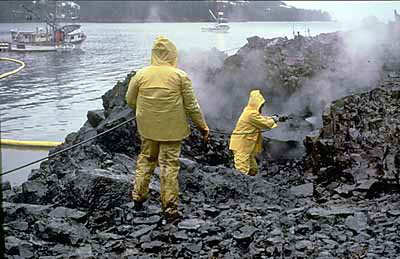BETTER LIVING THROUGH CHEMISTRY? Oil spill dispersants making people ‘oil sick’?
Sunday, January 5, 2024
A SanJuans.Today RECORDED LIVESTREAM IS AT THE BOTTOM OF THIS PAGE
IF YOU FIND YOURSELF looking for a new environmental protection project, this could be it. Dr. Riki Ott is completely focused on how America will respond to its next major oil spill. She makes the case that this is a danger that is vastly ignored. There are moments during this talk that remind one of the 1983 movie Silkwood.

In a presentation co-arranged by Friends of the San Juans and The Alert Project in late October Dr. Riki Ott made a presentation about a dispersal agent used in attempts to clean-up oil spills. Her presentation was held at the Brickworks meeting space in Friday Harbor, Washington.
The presentation was titled “OIL SPILL RESPONSE, An Opportunity for Change.”
Dr. Ott is a marine toxicologist who specializes in oil spills. She earned a PhD in sedimentary toxicology from the University of Washington. She happened to be operating a fishing business in Alaska in March 1989, the year of the Exxon Valdez oil spill in Prince William Sound. That’s when she became an activist. She is the founder of The Alert Project.
Twenty-one years later Dr. Ott found herself near the center of another epic oil spill, the Deepwater Horizon (British Petroleum) oil platform spill in the Gulf of Mexico (April 2010).
Dr. Ott’s presentation in Friday Harbor was meant to alarm, and it succeeded. She stands up to oil and chemical companies and confronts what she says are false claims about oil spills and environmental and human health impacts.
SanJuans.Today live-streamed the event in late October. Below is a recording of that live stream.
The event began with an introduction by Lovel Pratt, Marine Protection and Policy Director with the Friends of the San Juans.
Dr. Ott takes the stage at 3:15 minutes into the recording.
(4:00) What exactly is “oil spill response?” (It is not a clean-up.). Most of the oil ends up in the air, where it becomes a public health problem.
(6:20) We know more now. We can do better.
(6:55) People get sick from both the oil and the toxic products meant to disperse the oil. She now goes to major oil spills to coach people how to avoid getting sick during the “clean-up.”
(7:45) There is a great opportunity now to change the way we respond to oil spills. In 1990, the Federal government tried to empower local citizen groups to prepare for oil spills. Only in Alaska did the local groups make progress.
(12:55) A review of the local political aftermath of the Exxon Valdez oil spill in Alaska. How it “changed science.”
(15:50) First mention of the human health implications in the wake of oil spills, and the dispersants used — as well as the health of marine life.
(18:45) Have the manufacturers of the toxic dispersants disclosed the health implications of their products?
(22:00) Dr. Ott proposes the goal should be to persuade states to stop using the dispersants now, and to ban these dispersants now, and to begin testing new, better dispersant products.
(24:00) In 2011, the Federal government, including President Barack Obama, was informed that human health impacts from oil spill dispersants had been ignored.
(28:00) A brief description of current plans and options for dispersant use in Clallam County and San Juan County in the event of a large spill.
(30:00) A case study of “Lori and Dennis B.” in Mobile Bay in Alabama after the Deepwater Horizon spill in the Gulf of Mexico. “Lori” was directly sprayed with dispersant. Her health impacts included rashes, asthma, hair loss, blurred vision, and nose bleeds. A year later, Lori experienced even more severe health problems, including brain damage.
(38:00) EPA Regional Response Teams are reorganizing oil spill response plans right now. Dr. Ott says one state could set an important precedent. The plans will be reset in two years; the opportunity is now.
(41:00) Alaska has already divested itself of Corexit.
(42:45) Dr. Ott says, “All of this… what happens from this point forward depends on you all. This is really it. If we all step forward now, instead of protesting after a spill, and getting sick while we’re doing it. It’s worth the time to step forward now. Take some time. Get these letters in. And let’s do this. Let’s do this.”
(45:00) Beginning of Q&A. First question, Has “Lori B.” been compensated for her health problems?
(48:00) How have Alaska’s citizen advisory committees been so successful?
(56:00) From the audience, citizen Kim Sundberg explains that tankers out of Vancouver are delivering tar sands crude oil to mainland U.S. refineries, contrary to the original plans. He proposes that San Juan County develop an evacuation plan in the event of an oil spill near here.
(1:03:00) Dr. Ott elaborated on the unique quality of tar sands crude oil.
(1:07:20) Lovel Pratt reads a wrenching story submitted by an online viewer (SanJuans.Today streamed this presentation live) who wrote of toxic exposure during an oil spill clean-up, whose husband lost his business and his health.
(1:14:00) When the oil dispersants are mixed with the spilled oil they are meant to disperse, the mixture is more toxic than the oil alone. The cure is worse than the original threat.
(1:17:00) Animal rescue projects after an oil spill may not be as successful as widely perceived.
(1:19:40) How long do the dispersants last? Total recovery can take an estimated 30 years.
(1:24:55) Are only marine animals affected by residual dispersants? (No.)
(1:26:00) Have any good documentaries been produced on oil spill aftermath? Yes, said Dr. Ott. “It’s named ‘The Cost of Silence‘ (Conception Media).”
To read more about The Alert Project’s current campaign, click here.
WARNING: The video below features graphic medical photos, starting at approximately 30:00 minutes into the video and ending approximately 38:00 minutes into the video.






